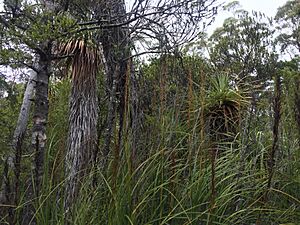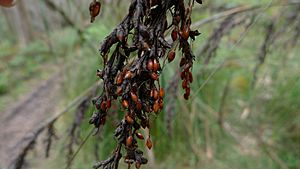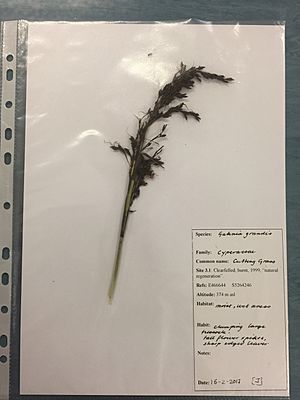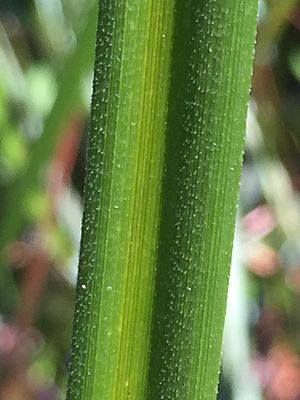Gahnia grandis facts for kids
Quick facts for kids Gahnia grandis |
|
|---|---|
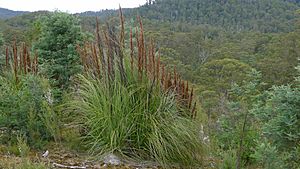 |
|
| Scientific classification | |
| Genus: |
Gahnia
|
| Species: |
grandis
|
| Synonyms | |
|
Scleria grandis Labill. |
|
Gahnia grandis is a tall, clumping plant that grows in southeastern Australia and Tasmania. It's a type of tussock plant, which means it grows in a dense clump.
This plant was first described in 1800 by a botanist named Jacques Labillardière. He called it Scleria grandis. Later, in 1969, S. T. Blake moved it to its current group, Gahnia. In Tasmania, Gahnia is a very common plant group, with seven different types growing there. Six of these are very large, upright grass-like plants. They have leaves with sharp edges, which is why they are often called cutting grass or cutty grass.
Contents
What is Cutting Grass?
Gahnia grandis is a sedge, which is a plant similar to grass. It grows in clumps and can reach 1 to 3 meters (about 3 to 10 feet) tall and 2 to 3 meters wide. Its flowering stems are strong and often spread out before standing up straight.
The leaves are flat, have brown bases, and are very sharp. They can be up to 2.5 meters (about 8 feet) long and spiral upwards. The flowers grow on long, tangled stems with drooping leaves. The main stems are thick, 1 to 3 meters high, and about 2 to 10 millimeters wide. They often sprawl for 1 to 2 meters from their base. This plant is found all over Tasmania.
How Cutting Grass Flowers and Seeds Grow
The flowers of Gahnia grandis can hang down. Their spikes, which are like long clusters of flowers, can be 50 to 100 centimeters (about 20 to 40 inches) long. They often grow on one side of the stem.
The flower heads look like a panicle, which is a branched cluster of flowers. Each small flower cluster, called a spikelet, has two flowers. The top flower can produce both male and female parts, while the bottom flower is either sterile or only male.
The lowest parts that protect the flower, called glumes, are much shorter than the upper ones. They have uneven, jagged edges that feel a bit rough. The tips of the upper glumes can be pointed or rounded. The flowers are creamy white and have 4 to 5 stamens, which are the parts that produce pollen.
The seeds look like small nuts and are smooth and dark reddish-brown to orange-brown. They are oblong or oval-shaped, about 3.0 to 4.5 millimeters long, and 1.2 to 1.9 millimeters wide.
Where Cutting Grass Lives
Gahnia grandis first grew in southern Australia. There are about 40 different Gahnia species found across Australia, Asia, and the Pacific Islands. This specific type of cutting grass is native to Western Australia, Queensland, New South Wales, Tasmania, and Victoria. In Victoria, it's found in areas like the Gippsland plain and Wilsons Promontory.
Gahnia plants are very common in Tasmania, with seven native types. These plants often grow in wet forests and are seen more frequently after a fire. They also live in coastal areas and sometimes in dry woodlands.
Another type, Gahnia rodwayi, is a smaller, grass-like plant found in dry forests in southeastern Tasmania. It usually flowers between October and January. This plant prefers moist soil near water, in shady forest valleys, and in areas with dappled to semi-shade.
Gahnia grandis is found in almost all parts of Tasmania, except for the midlands and northeast. It grows in poorly-drained soils from sea level up to the mountains. You can also find it at the edges of wetlands and forests, in areas near rivers, on button grass plains, and along roadsides and ditches.
Uses of Cutting Grass
For a long time, Indigenous peoples and Aboriginal Islanders have used cutting grass. They used it for weaving baskets and making strong ropes. The nuts from the plant were crushed and ground into flour to make bread. The soft, young bases of plants growing in wet places could also be eaten.
The seed heads of Gahnia grandis are very attractive and are used for decoration. Gahnia plants can also help attract birds and butterflies to an area. These plants provide a safe home for nesting birds, butterflies, caterpillars, and other insects and animals. This includes endangered animals like the eastern barred bandicoot.
Organizations like the World Wide Fund for Nature (WWF) and the Hobart City Council have supported projects to help conserve the eastern barred bandicoot. These projects teach people, especially primary school children, about the importance of protecting Gahnia grandis and other native plants.
Gahnia grandis is a tough plant. It can handle damp soil, dry periods, full sun or shade, and even moderate frost down to -4°C (25°F). This makes it useful in many different places. It's often planted to make the soil healthier and to stop soil from washing away (erosion). It's also planted along roadsides and around farms to create a natural boundary that protects marsupials and provides homes for insects.
Once dried, cutting grass can be used as fuel for fires. It can also be used to make crafts, wooden furniture, baskets, ornaments, and other decorative items. People also use it in vases or plant it in gardens as an ornamental plant.
Similar Plants
Many other Gahnia species look a lot like Gahnia grandis. They are also sometimes called cutting grass. However, you can tell them apart by looking closely at their seed heads, their overall structure, and the parts of their flowers.
How Cutting Grass Grows and Helps Nature
Gahnia grandis is a very strong, long-lasting grass species. It has woody roots that grow underground and forms large clumps. For most of the year, it grows in moist soil, often in areas that get flooded sometimes. Once it's fully grown, cutting grass can handle dry weather and strong winds.
It flowers from spring through summer. You can tell when the seeds are ready by the color of the flower head. The bright brown, unripe fruits turn black when they are mature. At this point, they are ready to be used for food.
Gahnia grandis is resistant to a plant disease caused by a water mold called Phytophthora cinnamomi. However, it catches fire very easily.
Many plants in the Cyperaceae family, including cutting grass, are important food sources and safe homes for native birds like the currawong. They also help native insects, moths, and butterflies, such as the chaostola skipper butterfly. The young caterpillars of the chaostola skipper eat Gahnia species, including Gahnia radula and Gahnia grandis, at night. The butterfly helps pollinate other plants. Many other insects also rely only on Gahnia plants for food.
Cutting grass depends on birds like the currawong to spread its seeds. The birds eat the fruit and then spit out the hard inner nut, which is partly digested. Scientists think that the birds' stomach acid helps the tough seed coat break down, making it easier for the seed to grow.
Cutting grass is also a very important habitat for the rare and endangered Burnie burrowing crayfish.
Growing Cutting Grass
Because of its long, sharp-edged leaves and somewhat messy look, cutting grass is not usually grown in gardens for beauty. However, it is very useful for restoring natural areas and helping plants grow back. Its toughness and ability to hold soil make it great for preventing soil erosion.
Gahnia species in general are hard to grow. The best way to grow them is from seeds, as trying to divide the plant or move it usually doesn't work well. The seeds need a long time before they will sprout, usually not germinating until at least 12 months after they are mature.
The best way to collect seeds is to cut off the seed heads at the base using pruning shears. Then, lay them out on a ground cover for several days to dry. You might need to shake or beat the dried seed heads to get the seeds out. Once collected, the seeds should be stored in a dry place to keep them healthy for longer.
Images for kids


